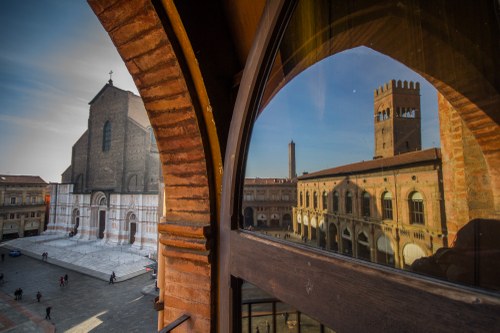About Bologna

A city full of history and culture
The City of Bologna, capital of the Emilia Romagna region, is located in a strategic position in the heart of Italy, midway between Milan and Florence. Situated on the edge of the Po Plain at the foot of the Apennine Mountains, the metropolitan area includes 55 Municipalities and has an overall population of about 1 million inhabitants (400,000 within the city boundaries)
With its strategic location, Bologna has been a primary crossroad of goods and people since the Roman times. Today, it is the centre of a transport and business network of vital importance for Italy and Europe. It is the major hub in the country for highway and rails. High-speed trains (Frecce, Italo) connect Bologna to Florence (37 minutes), Milan (65 minutes), Rome (2 hours and 15 minutes), Venice (less than 90 minutes) and other major destinations. Guglielmo Marconi International Airport (7.5 million passengers in 2016) is only 15 minutes away from the city center by bus. The Bologna Trade Fair District is one of the most important in Italy, hosting 27 trade shows, around 16.000 exhibitors, and almost 1 million visitors every year.
Bologna’s industrial system features outstanding internationally-relevant clusters, related to automatic machinery, motor industry, electronics, fashion, and agro-food industry. Other emerging sectors, such as logistics, medical technology, multimedia and creative industries, are contributing to create an excellent mixture of culture and technology, thus making Bologna a benchmark for innovation and technology development. Bologna offers a quality of life among the highest in Italy.
Designated as European Capital of Culture in 2000 and nominated UNESCO Creative City of Music in 2006, Bologna is a melting pot of European culture and Italian heritage, and home to a number of prestigious cultural, economic and political institutions.
The University of Bologna, founded in 1088, is the oldest in the Western world, and one of the most important in Italy: a higher education institution of international excellence, with a core district located in the heart of the city historical center.
The old town is one of the most beautifully preserved medieval centers in the world. Its “porticoes” (stretching for about 40 kilometers, recently proposed to the list of UNESCO World Heritage Sites), as well as the red bricks of its buildings, make Bologna unique. The medieval towers are a hallmark of the city, especially the Two Towers, a symbol of Bologna.
Bologna historical and artistic heritage is preserved in over 50 museums. The area called “Manifattura delle Arti” is one of Europe’s main cultural district, spread over an area of about 10 hectares, hosting the Museum of Modern Art in Bologna (MAMBO), the Department of Communication Sciences, the Music and Performing Arts Laboratories, and the Bologna Film Archives (Cineteca di Bologna). The latter is a worldwide renowned center for film programming and restoration, also preserving important collections such as the Charlie Chaplin archive.
Besides, many other institutions of international relevance, such as the Amilcar Cabral Centre (focused on the cultures of Asian, African and Latin American countries), the College of Spain and the China College, contribute to make Bologna a vibrant multicultural place and one of the best destinations in Italy.
For useful information about Bologna (getting here and around, maps, culture and history, monuments and places, itineraries, events, etc.), please visit the website Bologna welcome.